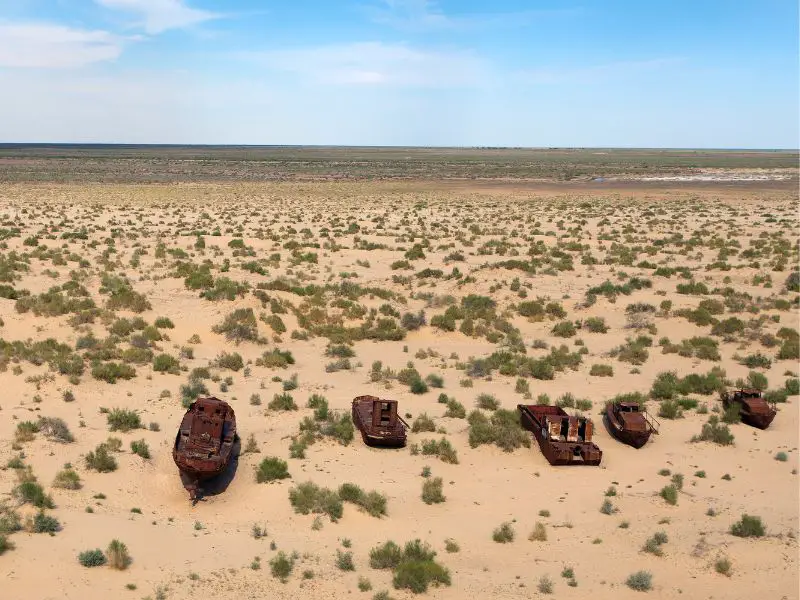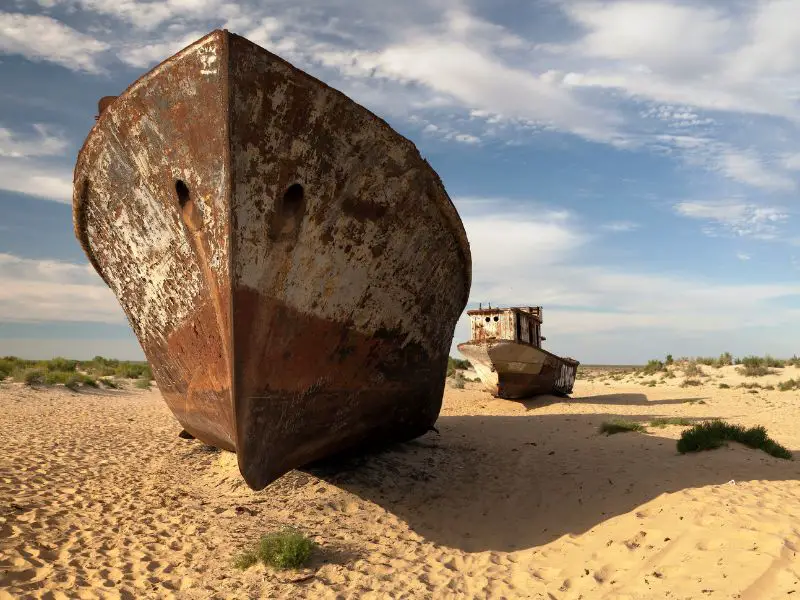The Aral Sea is (or was) the world’s fourth largest lake. The Aral Sea was once home to millions of fish, including sturgeon, carp, pike, and salmon; it also had a curved shoreline that once stretched roughly the size of the Netherlands.
But today, scientists estimate that only 10 percent of the lake is fishable due to pollution and the diversion of rivers for irrigation. Here, we’ll dive into the Aral Sea Disaster and look at what exactly happened.
The Aral Sea Disaster
Before the 1960s, the Aral Sea covered an area of 26,000 square miles in size and was bordered by dry steppes. This water body gave the Soviet Union tens of thousands of employees and more than 15 percent of its fish catch. However, this was not enough for the Soviet authorities, who during the second part of the 20th century decided to transform the arid territory into one of the largest cotton plantations in the world.

The two main rivers, nourished by snowfall and precipitation from distant mountains, were exploited to convert the desert into fields for cotton and other crops. Before the project, the Aral Sea used to be the fourth largest lake in the world.
As the drying of the Aral Sea quickens, fisheries and the people that rely on the lake have collapsed. Fertilizers and chemicals pollute the water, and it’s getting increasingly saline. The dust from the uncovered lakebed, which is tainted with agricultural pesticides, poses a threat to public health. In addition, with the loss of so much water, the climate in the region has become drier, and rain precipitation has reduced dramatically.
The Chemical Weapon Testing Site
The island of Vozrozhdeniye is situated in the center of the Aral Sea. Before 1948, Vozrozhdeniya was an unremarkable strip of land surrounded by the turquoise waters of the Aral Sea. The Soviet authorities transformed this 75-square-mile island that served as a launch site for local fishermen into a testing field for some of the most lethal chemical weapons in existence.

Hidden to the Western world, the island of Vozrozhdeniya became the site of the top-secret Aralsk-7 project. From the end of World War II until the fall of the Union, this secluded area remained a secret location where toxic chemicals and viruses were transformed into weapons. According to the BBC, anthrax was grown next to smallpox, bubonic plague, and “exotic diseases like tularemia, brucellosis, and typhus” in large vats where they were fermenting.
Health-Related Consequences
At the end of the 1990s, children from Kazakhstan who had been harmed by Aral Sea’ pollution were sent to a rehabilitation center in Almaty. The clinical findings revealed skin lesions, heart disease, and kidney disease. Children here often grew slowly and reached sexual maturity late.
Furthermore, anemia was linked to lakeside habitation, and nearby children had reduced renal tubular function. Hypercalciuria in children has also increased since the Aral Sea Disaster began. This is caused by consuming saline-rich water, food, and dust or by renal tubular dysfunction caused by toxic damage from lead and cadmium exposure.
Water Access
Drinking water has become an essential resource due to the absence of rivers that flow into the Aral Sea region. Water scarcity and pollution of drinking water are primary sources of fecal-oral illness transmission in Aral Sea region households. Hepatitis A and diarrhea are also widespread.
At the turn of the century, the newborn mortality rate because of diarrhea was twice as high as in neighboring districts. Parasitic diseases and Tuberculosis provide further difficulties. Some argue that the high prevalence of disease, particularly Tuberculosis , is caused by growing poverty, which leads to poor personal hygiene and malnutrition. Indeed, multi-drug resistant Tuberculosis is a significant problem in this region.
Revival of the Aral Sea
Uzbekistan won independence from the Soviet Union in 1991 and is determined to help the state of the dying Aral Sea. The Kazakhstan Government’s first two attempts failed, and it wasn’t until 2005 that it tasted success with a rise in water level and fish stocks in the sea.
Countries around the Aral Sea, including Kazakhstan, Uzbekistan, Tajikistan, Kyrgyzstan, and Turkmenistan, established the Aral Sea Basin Program in 1994 to revitalize the lake. In addition to reconstructing the disaster-stricken region around the Aral sea, the program’s primary objective was to restore environmental balance.

The first stage of the initiative got underway in 1992 with assistance from the World Bank and continued until 1997. The second phase began in 1998 and continued for the next five years, while the third phase continued simultaneously and focused on improving the irrigation systems that were already in place.
After strenuous efforts by Kazakhstan, the Aral Sea disaster experienced a slight improvement when its depth grew to 30 feet. The completion of the Dike Kokaral, a concrete dam that divides the two sections of the Aral Sea, was a significant milestone in 2015 since it aided in raising the water level and reducing the salinity of the Northern side of the Aral Sea.
The Comeback of Water After the Aral Sea Disaster
Today, the Aral Sea no longer exist. Instead, there are two separate bodies of water: the North Aral Sea and the South Aral Sea. In Kazakhstan, the North Aral Sea is sometimes called the “Small Sea” in Uzbekistan.
The North Aral Sea in Kazakhstan has been restored, with water and economic activity returning to Aralsk. On the other hand, the South Aral Sea in Uzbekistan is nearly totally dried, and its inhabitants are choking on the air.
In 2017, the government proposed an idea for a United Nations Multilateral Trust Fund for the Development of the Aral Sea Region. Currently, efforts are being made to reclaim the land from the desert and plant around two million hectares of trees and forests.
The European Union Bank is also looking at measures to assist in modernizing and rebuilding the existing irrigation and drainage infrastructure, which wastes a significant amount of resources, and achieve substantial water-saving objectives that range from 20 to 25 percent.
Restoring the lake will take time, but a good start has been made. With global warming and climate change posing a major threat to the Aral Sea region, protecting this natural ecosystem is essential.
The dry climate in the Aral Sea zone provides a perfect breeding ground for diseases like dengue, and the spread of tropical diseases is very likely in the future. Although the future of water in the Aral Sea region is still an enigma, it is sure to be an essential issue for years to come.
Related: Chemtrail Conspiracy Theory, Is It Illegal to Collect Rainwater, 10 World’s Largest Landfills

